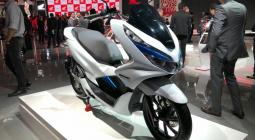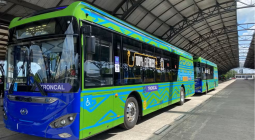How electric scooters are driving China's salt battery push
The country is racing ahead of the rest of the world in bringing sodium-ion batteries to the mass market. This time, through scooters.
Dozens of glitzy electric mopeds are lined up outside a shopping mall in the city of Hangzhou in eastern China, drawing passersby to test them.
But these Vespa-like scooters, which sell for between £300 and £500 ($400 and $660), are not powered by the mainstream lead-acid or lithium-ion cells, commonly used in electric two-wheelers. Instead, their batteries are made from sodium, an abundant element that can be extracted from sea salt.
Next to the scooters stand a few fast-charging pillars, which can replenish the vehicles' power level from 0% to 80% in 15 minutes, according to Yadea, the major Chinese two-wheeler manufacturer holding this promotional event in January 2025 for its newly launched mopeds and charging system. There is also a battery-swapping station, which enables commuters to drop in their spent cells in exchange for fresh ones with a scan of a QR code. (Read more about China's battery swap stations for electric vehicles here.)
Yadea is one of many companies in China trying to build a competitive edge in alternative battery technologies, a trend that shows just how fast the country's clean-technology industry is developing.
Even as the rest of the world tries to close its gap with China in the race to make cheap, safe and efficient lithium-ion batteries, Chinese companies have already taken a head-start towards mass producing sodium-ion batteries, an alternative that could help the industry reduce its dependence on key raw minerals.
Chinese carmakers were the first in the world to launch sodium-powered cars. But the impact of these models – all of them tiny with short ranges – has been low so far.
In April 2025, the world's largest battery manufacturer, China's CATL, announced its plan to mass-produce sodium-ion batteries for heavy-duty trucks and cars this year under a new brand Naxtra.
China's grid operators have also started to build energy storage stations using sodium-ion batteries to help the grid absorb renewables. This is an area considered by many researchers spoken to by the BBC as the main playground for the emerging technology.
Chinese companies' multi-pronged strategy in driving sodium-ion batteries will put it in a leading position of a global race – should there be one, says Cory Combs, who researches critical minerals and supply chains at Beijing-based consultancy Trivium China. He says it remains to be seen whether sodium-ion batteries will really take off.
But one segment that is betting big on sodium-ion batteries is the two-wheeler, a fast-growing and highly competitive market in China.
Yadea has brought three sodium-powered models to the market so far and is planning to launch more. It has also established the Hangzhou Huayu New Energy Research Institute to research emerging battery chemistries, particularly sodium-ion.
"We want to bring technology from the lab to customers fast," Zhou Chao, the company's senior vice president, said in January during a talk show on China Central Television in January.
Cue the 'little electric donkey'
Two-wheelers are an extremely popular mode of transport in many Asian countries, including Vietnam and Indonesia. In China, they are ubiquitous, carrying their owners to shops, offices, metro stations and everywhere in between. Because they are practical and versatile, the Chinese have given them an endearing nickname: "little electric donkeys".
"Two-wheeled vehicles typically operate over shorter distances and at lower speeds [than cars], making them less demanding in terms of energy density and power output," says Chen Xi, who researches energy storage materials and devices at Xi'an-Jiaotong Liverpool University in China. A sodium-ion battery carries significantly less energy than a lithium-ion battery of the same size, which means it has a lower energy density.
For two-wheelers, sodium-ion batteries' main rivals are lead-acid ones, whose energy density and rechargeable cycles are even lower. Their only advantage is that they are cheaper than both sodium and lithium-ion batteries currently, Xi says.
The sheer number of two-wheelers in Asia paves a promising pathway to achieving economies of scale. In China alone, around 55 million electric two-wheelers were sold in 2023 – nearly six times the number of all pure, hybrid and fuel-cell electric cars combined sold in the country that year – according to Shanghai-based consultancy iResearch.
Scale production was the goal of Yadea. Zhou said at the talk show that the firm was seeking to bring sodium batteries to tens of millions of ordinary commuters by not only fitting them into two-wheelers, but also building a charging ecosystem to enable people to use these models without stress.
To test the waters, in 2024 Yadea began a pilot programme with 150,000 food delivery couriers working in Shenzhen, a mega city of 17.8 million people in southern China, reported Shenzhen News. The goal was to enable them to hand in a spent Yadea sodium-ion batteries at its partners' battery-swapping stations in exchange for a fully charged one within 30 seconds, Yadea said.
Yadea and other companies, such as battery-swapping firm Dudu Huandian, have grown so rapidly in Shenzhen the city now aims to become a "battery-swapping city". It aims to install 20,000 charging or swapping pods for various types of batteries for electric scooters in 2025, and 50,000 by 2027, according to Shenzhen Electric Bicycle Industry Association, a trade body that is working with the Shenzhen government to promote battery swapping. The city – which already has a "battery-swapping park" – will build a vast network of battery swapping facilities to enable residents to find a station every five minutes, the trade body says.
Boom and bust
Sodium-ion and lithium-ion batteries have similar structures. The main difference is the ions they use – the particles shuttling back and forth between a battery's positive and negative sides to store and release energy.
Sodium is widely dispersed in the sea and the Earth's crust, making it about 400 times more abundant than lithium. Sodium-ion cells are therefore more accessible and potentially cheaper to produce at scale. They could also free the battery industry from choking points in current supply chains.
Lithium ore is currently predominantly mined in Australia, China and Chile, but the processing of the mineral is concentrated in China, which has nearly 60% of the world's lithium-refining capacity.
Sodium-ion batteries are not a recent invention. Their fate has been intertwined with that of lithium-ion batteries. The research and development of both cells began about half a century ago, with Japan leading the global effort. But after Japanese electronics company Sony launched the world's first lithium-ion battery in 1991, its huge commercial success led the development of sodium-ion technology to be largely paused – until the beginning of this decade. By then, China had become the dominant battery force worldwide through years of an industrial push by the government.
Cover photo: From Getty Images




